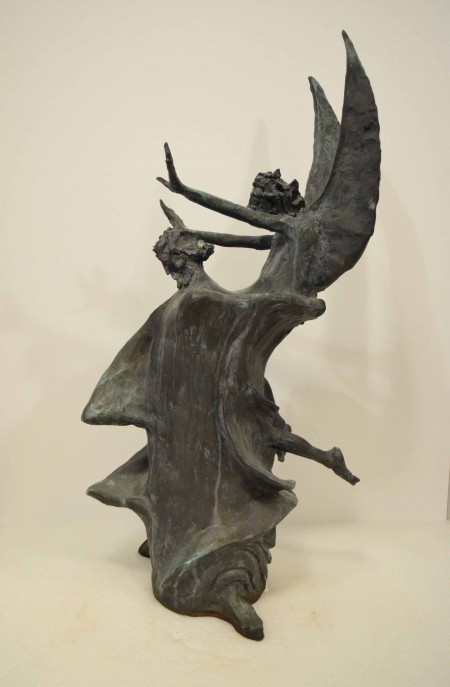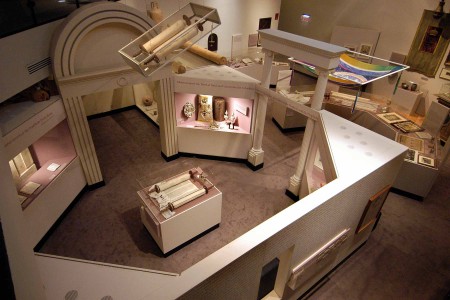Reimagining Cincinnati’s Skirball Museum
by Abby Schwartz, director, Cincinnati Skirball Museum of Hebrew Union College-Jewish Institute of Religion
On a bright sunny morning in mid-May of 2015, I stand outside the Skirball Museum on the historic campus of Hebrew Union College-Jewish Institute of Religion, watching as an eighteen-wheeler freight truck pulls into the drive. I am giddy with anticipation, realizing, even as the door of the truck rolls up revealing boxes and crates piled to the ceiling, that after this, nothing will be the same for our little museum, tucked neatly into Mayerson Hall on Clifton Avenue.
It strikes me that this scene has played out before. Similarly, in 1925, another truck arrived on the campus, bringing the Salli Kirschstein collection of Judaica. Under the stewardship of then library and museum director Adolph Oko, the Union Museum, which had been established in 1913—the first formally established Jewish museum in America—grew to include important European collections. I wonder what Oko envisioned for the museum as this shipment arrived. What surprises did it hold? How would the narrative unfold? What would it mean for the future of the museum?

The history of a Jewish museum on the campus of Hebrew Union College really begins shortly after the founding of the college in 1875, more than 140 years ago. Over time, the college began accepting donations of Judaic objects and books. In the 1920s, the collections rapidly expanded with the purchase of several significant private collections of Judaica. As it grew, the collection moved from the library to a gallery of art and artifacts, and eventually to Mayerson Hall, where in 1990 the Skirball Museum opened in a newly renovated and expanded former Masonic Temple. The museum’s core collection, An Eternal People: The Jewish Experience, offers seven thematic galleries that portray the cultural, historical, and religious heritage of the Jewish people: Immigration; Cincinnati Jewry; Archeology; Torah, Jewish Festivals and Life Cycle Events; The Holocaust; and Israel.
25 years later, the truck pulls onto the campus of Hebrew Union College, carrying the art and artifacts of the former B’nai B’rith Klutznick National Jewish Museum of Washington, D.C. The museum had closed in 2002, when B’nai B’rith International moved its headquarters. Nearly 1500 objects were permanently transferred to the Skirball Museum for the purposes of preserving and displaying this distinctive collection of sacred and secular fine and decorative arts. The holdings of our little museum were about to quadruple in size, making it the largest collection in the Midwest. How would this collection be absorbed? How would it change the narrative? Where would it lead the Skirball?

Just as the opening of the college in 1875 had sparked interest in the gathering of art and artifacts, the announcement of the B’nai B’rith Klutznick Collection transfer opened dialogue with artists and descendants of patrons who were delighted to learn that their treasures would once again be on view and were eager to reconnect with these works. Internationally renowned multimedia artist Phillip Ratner, best known for his eight bronze sculptures that stand at the base of the Statue of Liberty and his 33 statues housed in the National History Museum at Ellis Island, called to enthusiastically report about his seminal bronzes in the Klutznick Collection, and how the commission for these pieces helped launch his career as a sculptor. A descendant of Enrico Glicenstein (1840-1972) sent documentation about a bust of Franklin D. Roosevelt that had been on view in the B’nai B’rith headquarters and museum in Washington, D.C. Twice winner of the coveted Prix de Rome and gold medalist at the 1900 Paris Exposition, Glicenstein was said to be the only sculptor to have exhibited jointly with Auguste Rodin. The relationships that are now being built with artists and descendants of artists and patrons will inform the way in which these treasures are understood and interpreted as the Skirball plans for their display. As an institution which has as its mission the preservation, study, and display of the religious and cultural expression of the Jewish experience, the Skirball looks forward to engaging in renewed research and dialogue about objects of material culture. Unpacking, condition reporting, photography, documentation, storage, and display of portions of the B’nai B’rith Klutznick Collection are ongoing a year after its arrival. Discussions are underway regarding redesign, renovation and expansion of existing display space, all with an eye toward meaningful narrative and effective engagement for our visitors.

Apart from engagement with the B’nai B’rith Klutznick Collection, the Skirball is building a meaningful and important collection specific to Cincinnati’s history as a center for art and artists. A recent gift to the Skirball includes works by world-renowned sculptor Moses Jacob Ezekiel (1844-1917) and his circle. A bronze relief, works on paper, and sculpting tools of this American expatriate artist who lived in Cincinnati as a young man complement three major works by Ezekiel already in our collection, including a marble bust of Isaac Mayer Wise, who founded Hebrew Union College and was instrumental in establishing the major ideas and institutions of Reform Judaism in America. A pen and ink drawing of the artist’s studio relates directly to a pivotal work in Ezekiel’s career, the bronze relief Israel, which won the coveted Prix de Rome from the Berlin Royal Academy of Fine Arts in 1873. The original relief has disappeared. The Skirball houses a smaller 1904 version. A controversial piece, the artist appropriated Jesus Christ as the symbol of the suffering of the Jewish people.
Another recent acquisition is a portrait of noted Cincinnati industrialist and philanthropist Marcus Fechheimer (1818-1881). Born in Bavaria, Marcus came to America in 1837, where he worked as a peddler in Pennsylvania. He soon came to Cincinnati, and is representative of the wave of German Jewish immigration that occurred between 1820 and 1870. By 1855 Marcus was a partner in A. Fechheimer & Brother, Wholesale Clothiers. Marcus served on numerous boards and societies, including the Hebrew Relief Society, the Jewish Hospital Society, and the local Board of Education, and was an avid supporter of Music Hall. He was president of K.K. Bene Yeshurun (now Wise Temple) when Isaac Mayer Wise came to serve that congregation in 1854, and remained an active member of the congregation and close friend of Rabbi Wise throughout his life. The Fechheimer Brothers Company is still in business with headquarters in Cincinnati, manufacturing and distributing uniforms, and is now part of Berkshire Hathaway. Marcus’s eldest daughters married into established Jewish Cincinnati families. The eldest, Rosa, married S.B. Sachs, and Emily, the second child, married Alfred Seasongood. This portrait and others that have recently come into the Skirball’s collection provide an opportunity to explore an important narrative in our city’s history, a narrative that speaks of a fervent commitment of Cincinnati’s Jewish citizens to civic betterment through their leadership roles in philanthropy, politics, arts and culture.

A third area of growth for the Cincinnati Skirball Museum is as a haven for art that would be otherwise lost—art that has come to the museum from congregations that are closing or merging. A phenomenon that is not specific to the Jewish community, downsizing and consolidating resources is a fact of life for religious institutions across America. An extraordinary collaboration and close friendship between Rabbi David Jacobs and acclaimed artist David Holleman resulted in a treasured suite of stained glass windows that graced Temple Beth El of Quincy, Massachusetts for five decades. With the merger of Temple Beth El and Temple Shalom and a relocation to Blue Hills, the leadership of Temple Beth El sought a new home for their beloved windows. The Skirball Museum is honored to give these beautiful windows a renewed life on our Cincinnati campus, where they will be placed on view to bring light and inspiration to our community for years to come. At the ceremony celebrating the arrival of the windows at the museum, Dean Jonathan Cohen offered the following comments: “The generous gift of…stained glass windows addresses the highest values of the College-Institute and its Skirball Museum. We have throughout been and remain wholly dedicated to the preservation, study and display of the religious and scholarly expression of American Jewry in its rich and manifold settings and media. The Holleman windows, exploring such themes as Jacob’s Ladder, Revelation, Holocaust, Redemption, and Mt. Sinai constitute a fine expression of an American Jewish tradition that has graced and enriched Temple Beth El for many decades.”

A year after the arrival of the B’nai B’rith Klutznick collection, a reimagined Cincinnati Skirball Museum is multi-faceted. It is home to a remarkable collection of Judaica that traces a history of craftsmanship and artistic expression from biblical times to medieval Europe to contemporary Israel. It offers a Cincinnati-specific narrative that resonates with people of all faiths, and speaks to the major themes of immigration and assimilation. It is a haven for works of art and their stories that would otherwise disappear, now having the opportunity to be seen, to provide inspiration, to encourage dialogue and discourse. Soon, an interactive online database will provide access to documents and images of the collection, expanding its reach and encouraging new scholarship. The Skirball Museum looks forward to ongoing community engagement with its collections on local, regional, national and international platforms and to sharing its treasures and the stories they tell—stories that are expressive of Jewish cultural, educational, and spiritual continuity.
The Cincinnati Skirball Museum is located on the historic campus of Hebrew Union College-Jewish Institute of Religion, 3101 Clifton Avenue. Open hours are Tuesday and Thursday 11 am to 4 pm and Sunday 1 to 5 pm and by appointment by calling 513-487-3098 or by emailing [email protected].
